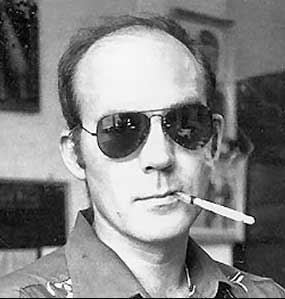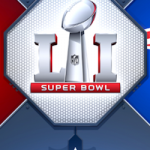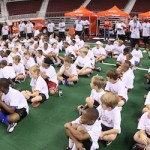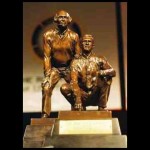By Simon Lee
… Green grass, hot sun, sharp cleats in the turf, thundering cheers from the crowd, the menacing scowl on the face of a $30,000-a-year pulling guard as he leans around the corner on a Lombardi-style power sweep and cracks a sharp plastic shoulder into the linebacker’s groin….
Ah yes, the simple life: Back to the roots, the basics — first a Mousetrap, then a Crackback & a Buttonhook off a fake triple-reverse Fly Pattern, and finally The Bomb….
Indeed. There is a dangerous kind of simple-minded Power/Precision worship at the root of the massive fascination with pro football in this country, and sportswriters are mainly responsible for it. With a few rare exceptions like Bob Lipsyte of The New York Times and Tom Quinn of the (now-defunct) Washington Daily News, sportswriters are a kind of rude and brainless subculture of fascist drunks whose only real function is to publicize & sell whatever the sports editor sends them out to cover….
Which is a nice way to make a living, because it keeps a man busy and requires no thought at all. The two keys to success as a sportswriter are: 1) A blind willingness to believe anything you’re told by the coaches, flacks, hustlers and other “official spokesmen” for the team-owners who provide the free booze … and: 2) A Roget’s Thesaurus, in order to avoid using the same verbs and adjectives twice in the same paragraph. …
 Only two weeks shy of 42 years ago, this first appeared in Rolling Stone, written by Hunter S. Thompson. He started and ended his professional career writing sports, first on the Elgin Air Force Base in the Florida panhandle for the base newspaper, and in the end, he was writing a column on sports and more for ESPN’s website. That column, called “Hey Rube,” appeared “regularly” on what was billed at the time on ESPN as “Page 2.”
Only two weeks shy of 42 years ago, this first appeared in Rolling Stone, written by Hunter S. Thompson. He started and ended his professional career writing sports, first on the Elgin Air Force Base in the Florida panhandle for the base newspaper, and in the end, he was writing a column on sports and more for ESPN’s website. That column, called “Hey Rube,” appeared “regularly” on what was billed at the time on ESPN as “Page 2.”
In between, Thompson penned what many say was the first piece of “Gonzo Journalism” with his masterpiece, “The Kentucky Derby is Decadent and Depraved,” which originally appeared in Scanlons in June of 1970.
He covered more ground in four paragraphs than most writers could in four (hundred?) books. He tackled larger social themes shrouded in sports, sports analogies, memories of sporting events and athletes than any other American writer before or since.
Lest we forget, Fear and Loathing in Las Vegas: A Savage Journey to the Heart of the American Dream begins as an assignment for Thompson to write a cutline for a photo to appear in Sports Illustrated while covering an annual desert race, the Mint 400, but is actually the hook (and the expense check) for him to write a tome concerning the Death of the American Dream.
Deep stuff. Funny stuff. Clever stuff. Sporty stuff.
If you’ve never read Fear and Loathing on the Campaign Trail 1972, you should, or at least read the part about how Thompson claims to have gotten one-on-one time with Richard Nixon during the campaign of 1968 because he was the only member of the press corp who could chat it up with Nixon – about football.
Thompson chose powerful words on Feb. 20, 2005, about two weeks after the Super Bowl, as the lede of his final note: “No More Games.”
That sums it up for many, as we gather around in the dens and the sports bars and with family and with friends to honor this de facto National Holiday in our own odd ways – some focused on the game (some with money at stake), some focused on expensive television advertisements, some focused on food and drink and more food and more drink.
But the Super Bowl represents the end of a season of a sport that has become the obsessive component of many an American Life.
Yes, only a few days later we get National Signing Day, where 17-year-old and 18-year-old boys are televised slipping on a hat, announcing where they intend to play college ball, everyone of them with dreams of playing in the Super Bowl driving the hand that picks up the hat with a team logo on it.
And in a few short weeks, Spring Football starts on college campuses around the country, a season itself, with a “Final Game” of Color v. Color. A game that draws 1,000s to the stands in some places and tens of thousands in others.
The Draft, a game within a game and another season itself, that days-long event, is just around the corner.
And then we begin the summer months: New uniforms? Someone got arrested? We’re going to the BIG game this year, I can feel it! Did you hear so-and-so didn’t show up for training camp?!
So with the final tick of the clock in Arizona this year, in the final game of a football season, the Super Bowl’s ending doesn’t represent “No More Games.” There are always games being played in this sport. The season never really ends at all.
Enjoy the food, the family, the friends, the game, the ads, and the knowledge football season continues.
Look for us on Twitter Sunday here @SportingLifeArk, and we will share together this National Holiday – this climax of a football experience that begins with dreams of boys who catch a pass for the first time and is fueled by fans who long for just one more game each season. Join us for Fear and Loathing at the Super Bowl.












